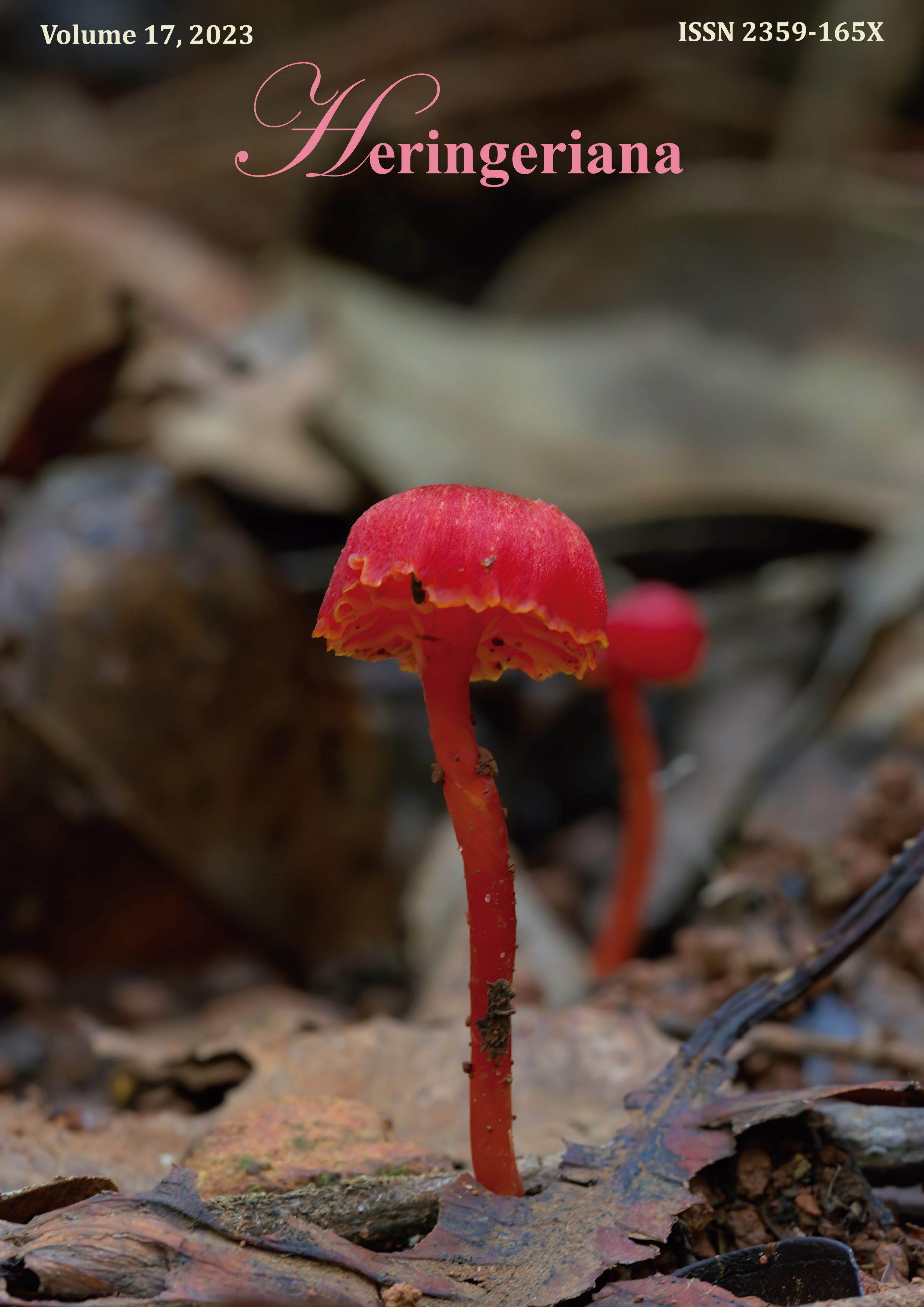The masked robber: Blue Dacnis steals nesting material from a Crested Becard nest in southeastern Brazil
DOI:
https://doi.org/10.17648/heringeriana.v17i1.918029Keywords:
Nest building, Atlantic Forest, Parasitism, PiracyAbstract
This study reports the first recorded case of nest material kleptoparasitism in the Thraupidae family, involving a Blue Dacnis (Dacnis cayana) and a Crested Becard (Pachyramphus Validus) nest. Kleptoparasitism is a behavior in which one individual steals food or resources from another, and nest material kleptoparasitism specifically refers to the theft of nesting material. The Blue Dacnis successfully stole nesting material from the Crested Becard's nest without being noticed. This behavior offers advantages such as reduced effort in finding material and decreased predation risk, but also carries risks such as defense by the nest owners and the possibility of carrying pathogens. This observation expands our understanding of kleptoparasitic behaviors in Neotropical passerines.
References
Amat, J.A. & Soriguer, R.C. (1984) Kleptoparasitism of coots by gadwalls. Ornis Scandinavica, 15: 188–194. https://doi.org/10.2307/3675962
Bélisle, M. & Giroux, J.F. (1995) Predation and kleptoparasitism by migrating parasitic jaegers. Condor, 97: 771–781. https://doi.org/10.2307/1369185
Burger, J. & Gochfeld, M. (1979) Age differences in ring-billed gull kleptoparasitism on starlings. The Auk, 96: 806–808.
Brockman, H.J. & Barnard, C.J. (1979) Kleptoparasitism in birds. Animal Behaviour, 27:487–414. doi: https://doi.org/10.1016/0003-3472(79)90185-4.
Brown, G.R., Almond, R.E.A. & Van Bergen, Y. (2004) Begging, stealing, and offering: food transfer in nonhuman primates. Advances in the Study of Behavior, 34:265–295. https://doi.org/10.1016/S0065-3454(04)34007-6
Cooper, W.E. & Pérez-Mellado, V. (2003) Kleptoparasitism in the Balearic Lizard, Podarcis lilfordi. Amphibia-Reptilia, 24:219–224.
https://doi.org/10.1163/156853803322390480.
Chavez-Ramirez, F. (1995) Sex-biased kleptoparasitism of hooded merganser by ring-billed gulls. Wilson Bulletin, 107: 379–382.
Dunn, E.K. (1973) Robbing behaviour of roseate terns. The Auk, 90, 641–651. https://doi.org/10.2307/4084163.
Ens, B.J., Esselink, P. & Zwarts, L. (1990) Kleptoparasitism as a problem of prey choice: a study on mudflat-feeding curlews, Numenius arquata. Animal Behaviour, 39: 219–230.
https://doi.org/10.1016/S0003-3472(05)80866-8
Escrivà-Colomar, I. & Rodríguez-Rodríguez, E.J. (2016) Un caso de cleptoparasitismo intraespecico en Natrix maura. Boletín de la Asociación Herpetológica Española, 27: 29–31.
Furness, R.W. (1978) Kleptoparasitism by great skuas (Catharacta skua Brünn.) and Arctic skuas (Stercorarius parasiticus L.) at a Shetland seabird colony. Animal Behaviour, 26: 1167–1177.
https://doi.org/10.1016/0003-3472(78)90107-0.
García, G., Favero, M. & Vassallo, A. (2010) Factors Affecting Kleptoparasitism by Gulls in a Multi-Species Seabird Colony (Factores que Afectan el Cleptoparasitismo por Gaviotas en una Colonia Multiespecífica de Aves Marinas). The Condor, 112: 521–529. https://doi.org/10.1525/cond.2010.090117.
Grimm, M.P. & Klinge, M. (1996) Pike and some aspects of its dependence on vegetation. In: Craig, JF (ed.). Pike: biology and exploitation. Chapman and Hall, New York, EUA, pp. 125–126.
Hesp, L.S. & Barnard, C.J. (1989) Gulls and plovers: age-related diferences in kleptoparasitism among black-headed gulls (Larus ridibundus). Behavioral Ecology and Sociobiology, 24: 297–304.
https://doi.org/10.1007/BF00290906.
Iyengar, E.V. (2004) Host-specific performance and host use in the kleptoparasitic marine snail Trichotropis cancellata. Oecologia, 138:628–639.
https://doi.org/10.1007/s00442-003-1467-1.
Jones, K.C., Roth, K.L., Islam, K., Hamel, P.B. & Smith III, C.G. (2007) Incidence of Nest Material Kleptoparasitism Involving Cerulean Warblers. The Wilson Journal of Ornithology, 119(2):271–275. https://doi.org/10.1676/05-145.1.
Källander, H. (1977) Piracy by black-headed gulls on lapwings. Bird Study, 24: 186–194. https://doi.org/10.1080/00063657709476555.
Krebs, J.R. & Dawkins, R. (1984) Animal signals: mind-reading and manipulation. In: Krebs J.R. & Davies, N.B. (eds.). Behavioural Ecology: An Evolutionary Approach. 2nd ed. Blackwell Scientific Publications, London, UK, pp. 125–126.
Kruuk, H. (1973) The spotted hyena: a study of predation and social behaviour. Journal of Animal Ecology, 42(3): 822–824. https://doi.org/10.2307/3145.
Maldonado-Coelho, M. & Duraes, R. (2003) The Black-Goggled Tanager (Trichothraupis Melanops): An Occasional Kleptoparasite in Mixed-Species Bird Flocks and Ant Swarms of Southeastern Brazil. Ornitologia Neotropical, 14(3): 397–404.
Maxson, S.J. & Bernstein, N.P. (1982) Kleptoparasitism by South polar skuas on blue Morand-Ferron-eyed shags in Antarctica. Wilson Bulletin, 94: 269–281.
Mello, D.J.M., Mello, G.J.M., Rodrigues-Mallet, F. & Lima, L.M. (2020) Aves do Sudeste do Brasil: Guia de Identificação. Edições do autor, Rio de Janeiro, Brazil, 400pp.
Partida, A. & Rodríguez-Estrella, R. (2015) Evidencia de cletoparasitismo del caracara común (Caracara cheriway) sobre el alcaudón verdugo (Lanius ludovicianus). Acta zoológica Mexicana, 31(2): 306–308. https://doi.org/10.21829/azm.2015.312987.
Rothschild, M. & Clay, t. (1952) Fleas, Flukes and Cuckoos: a study of bird parasites. Collins, London, UK, 364pp.
Shealer, D.A., Floyd, T. & Burger, J. (1997) Host choice and success of gulls and terns kleptoparasitizing brown pelicans. Animal Behaviour, 53: 655–665. https://doi.org/10.1006/anbe.1996.0340.
Sick, H. (1997). Ornitologia brasileira (edição revista e ampliada por José
Fernando Pacheco). Editora Nova Fronteira, Rio de Janeiro, Brazil, 912pp.
Sigrist, T. (2013) Guia de campo Avis Brasilis: Avifauna Brasileira. Avis Brasilis, São Paulo, Brazil, 591pp.
Siverino, F., Rodríguez, B., Rodríguez, A. & Siverio, M. (2017) Cleptoparasitismo en busardos ratoneros canarios. Quercus, 381: 12–14.
Skutch, A.F. (1962) Life Histories of Honeycreepers. The condor, 64(2): 92–116. https://doi.org/10.2307/1365479.
Slager, D.L., McDermott, M.E. & Rodewald, A.D. (2012) Kleptoparasitism of Nesting Material from a Red-faced Spinetail (Cranioleuca erythrops) Nest Site. The Wilson Journal of Ornithology, 124(4):812–815.
https://doi.org/10.1676/1559-4491-124.4.812.
Spear, L. & Ainley, D.G. (1993) Kleptoparasitism by kermadec petrels, jaegers, and skuas in the eastern tropical Pacific: evidence of mimicry by two species of Pterodroma. The Auk, 110: 222–233.
https://doi.org/10.1093/auk/110.2.222.
Taylor, I.R. (1979) The kleptoparasitic behaviour of the Arctic skua Stercorarius parasiticus with three species of tern. Ibis, 121: 274–282.
https://doi.org/10.1111/j.1474-919X.1979.tb06844.x.
Thompson, D.B.A. (1986) The economics of kleptoparasitism: optimal foraging, host and prey selection by gulls. Animal Behaviour, 34: 1189–1205. https://doi.org/10.1016/S0003-3472(86)80179-8.
Vollrath, F. (1984). Kleptobiotic interactions in invertebrates. In: Barnard CJ [ed.], Producers and scroungers: strategies of exploitation and parasitism. Chapman and Hall, New York, USA, pp. 61–94.
Whittaker, A. & Kirwan, G.M. (2008) Natural history data for the canopy-dwelling purpletufts Iodopleura (Cotingidae), and first documentation of Dusky Purpletuft I. fusca for Brazil. BOC Bulletin, 128(1): 28–35.
Wynia, A.L. & Bednarz, J.C. (2021) Evidence of nest material kleptoparasitism in Worm-eating Warblers (Helmitheros vermivorum) in east-central Arkansas, USA. Nature Notes, 11: 1–5. https://doi.org/10.1002/ece3.7339
Downloads
Published
How to Cite
Issue
Section
License
Copyright (c) 2023 Elsie L. Rotenberg, Lucas Botelho, Edelcio Muscat

This work is licensed under a Creative Commons Attribution 4.0 International License.
By submitting, the authors declare that they have not submitted the work to another journal and agree to have their article published under a Creative Commons Attribution 4.0 International BY License (CC BY 4.0), which means that authors retain ownership of the copyright but anyone can use the published content provided the original authors and source are cited. The scientific, orthographic and grammatical content is the full responsibility of the authors.








